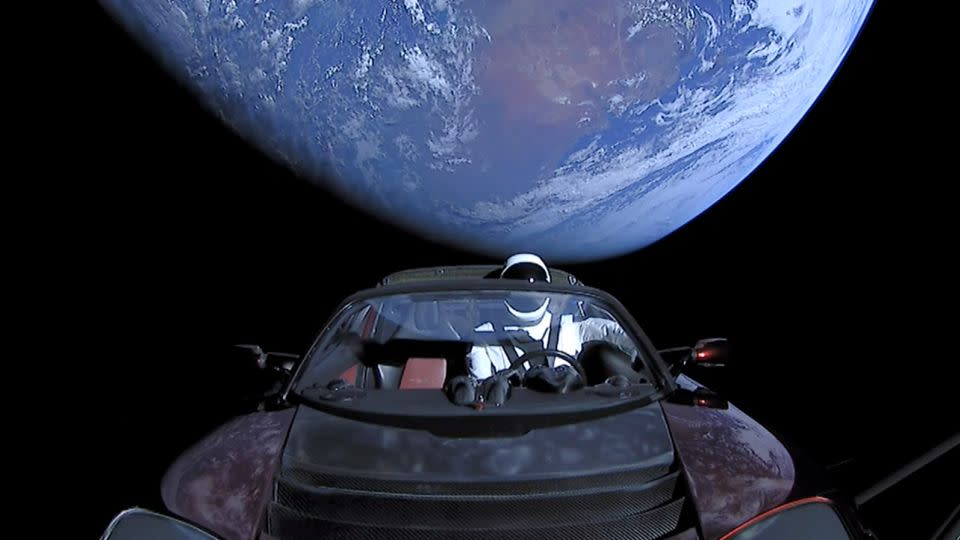Sign up for CNN’s Wonder Theory science newsletter. Explore the universe with news on fascinating discoveries, scientific advancements and more.
Seven years after SpaceX launched Elon Musk’s cherry red sports car into orbit around our sun, astronomers unwittingly began paying attention to its movements once again.
Observers spotted and correctly identified the vehicle as it started its extraterrestrial excursion in February 2018 — after it had blasted off into space during the Falcon Heavy rocket’s splashy maiden launch. But more recently, the car spawned a high-profile case of mistaken identity as space observers mistook it for an asteroid.
Several observations of the vehicle, gathered by sweeping surveys of the night sky, were inadvertently stashed away in a database meant for miscellaneous and unknown objects, according to the International Astronomical Union’s Minor Planet Center.
An amateur astronomer noticed a string of data points in January that appeared to fit together, describing the orbit of a relatively small object that was swooping between the orbital paths of Earth and Mars.
The citizen scientist assumed the mystery object was an undocumented asteroid and promptly sent his findings to the MPC, which operates at the Harvard Smithsonian Center for Astrophysics in Cambridge, Massachusetts, as a clearinghouse that seeks to catalog all known asteroids, comets and other small celestial bodies. An astronomer there verified the finding.
And thus, the Minor Planet Center logged a new object, asteroid “2018 CN41.”
Within 24 hours, however, the center retracted the designation.
The person who originally flagged the object realized their own error, MPC astronomer Peter Veres told CNN, noticing that they had, in fact, found several uncorrelated observations of Musk’s car. And the center’s systems hadn’t caught the error.

Cameras attached to the Tesla sports car capture a photograph of the vehicle in February 2018 after launching atop a SpaceX Falcon Heavy rocket. – SpaceX/Getty Images
“(The amateur astronomer) was correct. (The data points) really did belong together,” said Veres, who created the database entry for 2018 CN41. “But again, we just receive the numbers — the positions, and even the astronomers (using) telescopes, they just see a dot that is moving.
“So from that perspective, if you don’t know up front it’s a Tesla Roadster, there is no way to tell,” Veres added.
It was a remarkable case of mistaken identity. But it was far from the first, as a host of similar cases have troubled astronomers. The mix-ups highlight difficulties with tracking objects in deep space — a problem exacerbated by the growing number of human-made objects getting jettisoned into the ether.
Rock or rocket?
Objects traversing our solar system have been misidentified several times in recent years, NASA’s Paul Chodas recalled to CNN. Chodas is director of the Center for Near Earth Object Studies at NASA’s Jet Propulsion Laboratory in Pasadena, California.
Space experts had mistaken a rocket body on a collision course with the moon for a SpaceX launch vehicle before it was confirmed in 2022 to be a rocket booster from one of China’s past lunar missions.
A piece of the Apollo 12 mission’s Saturn V rocket, which carried three astronauts on the second crewed moon landing in 1969, baffled scientists in the early 2000s when it came back into Earth’s orbit. Astronomers had to closely inspect the discarded hardware’s bizarre trajectory to make an accurate identification.

The Apollo 12 Saturn V rocket vents a cloud of liquid oxygen, a type of propellant, on November 3, 1969, during a countdown demonstration test on the launchpad. – NASA
The University of Hawaii’s Pan-STARRS1 telescope spotted another rocket part in 2020 that helped launch NASA’s doomed Surveyor 2 lunar probe in 1966 during the height of the 20th century space race. The detection confounded researchers until the US government ordered a “high-level inter-agency” effort to figure out what the object was, Chodas said.
Interest, and sometimes urgency, in understanding and tracking deep-space objects stems from a desire to fundamentally understand the workings of the cosmos as well as helping policymakers and scientists understand threats — whether those threats are asteroids or foreign adversaries.
Evading professional astronomers
Musk’s sports car managed to sneak back up on the professionals charged with tracking objects in our solar system for several reasons.
One key factor: Experts haven’t been all that interested in keeping tabs on the vehicle.
The car is not on a voyage of scientific pursuits. It was sent to space as a piece of deadweight on the inaugural test flight of SpaceX’s Falcon Heavy rocket, and the vehicle is now destined to spend eternity soaring aimlessly through our cosmic neighborhood.
The car has an extremely small chance of ever impacting Earth. So as far as astronomers are concerned, it’s just a hefty piece of space junk.
Still, mistaking a spacecraft or human-made object for an asteroid is troublesome for the Minor Planet Center, which is tasked only with identifying naturally occurring objects.
“We don’t want to receive (data about) any artificial objects at all,” Veres said. “It’s basically wasted time for us,” he added, referring to the MPC.
The center is working with NASA’s Jet Propulsion Laboratory to better integrate data from the agency’s Horizons System database, which keeps close tabs on space rocks’ trajectories and flags potentially dangerous asteroids.
Veres said he wrote code that aims to better scan for human-made objects that may slip through the Minor Planet Center’s filters by cross-checking with the NASA Horizons database. The fix was implemented this week, Chodas said.
If that adjustment had been made earlier, he added, the patch almost certainly would have caught the error.
‘Not bulletproof’
Still, Veres added, updating code is not a catchall solution.
“It’s still not bulletproof,” he said, “and the issue is the number of new launches of spacecrafts.”
Today, the world of spaceflight is driven as much by the commercial industry as it is by government agencies such as NASA, he noted. And private companies are not always transparent about exactly where the objects they send to space are going. It’s a problem exacerbated by the fact that companies are launching far more frequently than government space programs ever have.
SpaceX, for example, launched nearly 140 rockets in 2024 alone — more than NASA launched during the entire 30-year Space Shuttle program.
The problem is not just satellites and spacecraft, Veres noted, but the rocket parts that are occasionally flung out into the abyss after they finish a mission.
While both JPL and MPC focus squarely on cataloging and tracking natural asteroids, comets and other natural bodies — the day will come when astronomers must begin closely watching human-made objects in deep space as well, Veres said.
Right now, Chodas estimates there are about 100 human-made objects in orbit around the sun, and “most of (those objects) are lost because they’re not tracked much,” he said.
“The bottom line is this: There’s not a reliable database of orbits of these objects around the sun,” Chodas added.
That lack of data could be a problem, as the increased traffic could muddy astronomers’ view of space and complicate the work of tracking asteroids that could strike Earth.
“I think this topic will become more urgent in upcoming years,” Veres added.
A mysterious pursuit
One case in point: AstroForge is a bold startup based in Huntington Beach, California, that aims to one day mine rare metals in deep space. The company plans to launch a small spacecraft, called Odin, in late February to fly by an asteroid and snap images to investigate its surface.
The mission marks one of the first times a private company has sent a spacecraft into deep space, or beyond the moon.

AstroForge’s Odin spacecraft is seen in the company’s factory. – Matt Gialich/Wesley Tunelius/Emerson Nino
At first, the company declined to publicly say which asteroid it would target, leaving open the possibility that observatories could unwittingly spot the spacecraft. AstroForge relented after pushback from the astronomy community, acknowledging in January that it aimed to send the vehicle to an asteroid called 2022 OB5 — a relatively small space rock that will pass less than 500,000 miles (800,000 kilometers) from Earth next year.
But the company’s CEO, Matthew Gialich, told CNN that things could change. “One of the best things we have as a company is we can change targets at any time … so it’s not a huge deal to me to say this one,” he said.
“Now, when we find this mythical asteroid that’s purely platinum and is worth $1 trillion in actual material — am I going to tell the world which one it is?” Gialich said, “Probably not.”
Clouding the skies
National security concerns are another issue that can cloud astronomers’ ability to see the cosmos clearly, as the president of the American Astronomical Society, Dara Norman, pointed out in a letter published in September that calls for better transparency.
“Some US government funded astronomical surveys have been restricted from publishing data … including deep space objects beyond 100,000 (kilometers),” Norman said in the letter. “The practice … should be reviewed to determine if there are in fact any national security reasons for applying such restrictions.”
The letter also states that, even though spacefaring countries and companies are required by a United Nations resolution to make public where objects they launch to space are heading, that mandate is “largely ignored for deep space objects.”
That, along with the fact that private companies are launching objects at unprecedented rates, is among the reasons scientists are concerned about their current abilities to track objects in our solar system, the letter noted.
“(T)ransparency is essential for promoting space situational awareness, reducing interference between missions, avoiding interference with observations of natural objects, including observations of potentially hazardous asteroids,” Norman noted in the September letter, “and ensuring the peaceful exploration and use of outer space, including the Moon and other celestial bodies.”
For more CNN news and newsletters create an account at CNN.com
#Astronomers #thought #Elon #Musks #Tesla #Roadster #asteroid #points #broader #problems #tracking #objects #deep #space












Leave a Reply